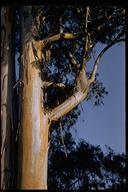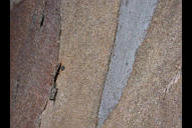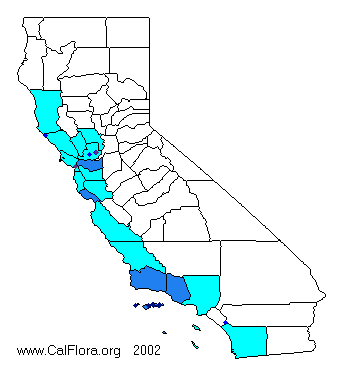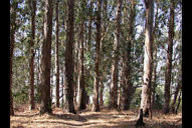

Common Name: Tasmanian Blue Gum
Scientific Name: Eucalyptus globulus Labill.
Classification:
Phylum or Division: Plantae
Class: Magnoliopsida
Order: Myrtales
Family: Myrtaceae
Identification:
The Tasmanian Blue Gum
tree is part of a larger group of evergreen trees native to Tasmania and
Australia collectively called Eucalyptus that can grow up to 400 feet tall
in their native habitat. The Tasmanian Blue Gum grows rapidly, up to
80 feet in its first 20 years, and can reach heights of up to 160 feet in
its introduced habitat in California, actively growing in the all but the
summer season. Of the species of eucalyptus introduced worldwide, it
is the one most commonly encountered. The tree can grow in a variety
of soil types in communities with mild weather and a high moisture content.
It cannot tolerate cold, frost, drought, or harsh winds, requiring at least
240 frost free days, and temperatures above 17°F.
The Blue Gum tree, as
it is sometimes known as, is called such due to a sticky gum-like substance
that the tree secretes. This gum is very fragrant and contains anti-bacterial
properties which make the tree extremely pest-resistant, as well as acting
as a deterrent to the growth of other non-eucalyptus plants. The smooth,
brown outer bark of the Blue Gum peels in large pieces to reveal large patches
of bluish-white bark underneath, giving the tree a piebald appearance.
The gray-green leaves grow in thick, smooth, and rounded and gradually stretch
out to a sharp elliptic-shape. The yellow flowers produced by the Blue
Gum in the fall lack petals and so assume a feathery starburst pattern with
the multitude of stamens arising from the calyx. The multitude of black
seeds produced winter to fall have a propagation rate and a moderate wind
dispersal distance of up to 20 meters. The trees prefer to grow in dense
stands, from as little as 170 trees per acre up to 1200. The Blue Gum
tree does not propagate vegetatively on its own, but can be transplanted from
the bare roots through human intervention.

Original Distribution:
The Tasmanian Blue Gum
is native to Tasmania, as the name suggests, and Australia. It is restricted
to the southeast coast and small areas of the west coast of Tasmania, the
islands to the north of Tasmania in the Bass Straight, and to southern Victoria
in Cape Otaway and Wilson’s Promontory in Australia.

Current Distribution:
The Tasmanian Blue Gum
is currently invasive in the United States in California and Hawaii.
It has invaded riparian habitats, grasslands, any habitat with a high soil
moisture content and a moderate climate. In California, it is located
along the costal ranges, from the north in Humboldt County all the way down
the state to San Diego County, growing the most successfully in the foggy
coast surrounding the San Francisco Bay Area. In Hawaii, the 12,000
acres are mostly located on Hawaii and Maui.
The Blue Gum has been successful introduced in the hills of first northern and then southern, surviving at altitudes up 2200 m where there is adequate rainfall. There are vast plantation located in Southeast Asia, Southern Europe, and Brazil for commercial purposes. It is also growing successfully in the areas of Ethiopia and Argentina which have summer rainfall. Almost 15% of Portugal’s land area is covered in the Blue Gum tree.
Site and Date of Introduction:
Eucalyptus globulus was
introduced into India beginning in the late 1700s. Its import into
Brazil is hazy, with some reporting the first introduction of the eucalyptus
into the Botanical Garden of Rio de Janeiro by the director of the garden
in 1824. But the first known introduction of the E. globulus was by
Edmundo Navarro de Andrade, an agronomist who planted the first seeds in
São Paulo in 1904.
The Blue Gum was brought to California in 1856 and Hawaii in 1865. It was also introduced and is still found in Arizona as an ornamental species, but has not become naturalized due to the dry climate.
Mode(s) of Introduction:
People deliberately imported
the Tasmanian Blue Gum tree for economic and ornamental purposes.
Since then, it has found a favorable habitat and has aggressively spread
into the natural habitat, forcing out other forms of vegetation by inhibiting
the growth and germination of other plants.
Reason(s) Why it has Become Established:
One of the main reasons
the Tasmanian Blue Gum tree has become established is because of its great
economic importance. It grows rapidly and can be used for a large
variety of timber products, and so was deliberately aggressively imported
into areas that were comparable to its original environment. It did
not have to adapt to vastly different surroundings to become established.
Its rapid growth rate, dense stands, and ability to suppress outside vegetation
made it easy for even one tree to rapidly clear the surrounding area and
prepare the area for other eucalyptus. Its saplings have a very high
rate of survival due to the fact that it is very rarely eaten by large herbivores.
Its ability to survive a large range of terrain types, from coarse to fine
soil, sea level up to around 1000 feet in altitude, means that the only limiting
factors in range are temperature and water content. In California, the
tree is able to withstand the long dry periods because of the frequent fog.

Ecological
Role:
The Tasmanian Blue Gum
is rich in nectar and so are a good crop for bees and hummingbirds.
They inhibit the growth of other vegetation and so create virtual monocultures
of various eucalyptus trees, with the exception of a few hardy grasses.
They provide habitats for insects and birds which do not interact with the
tree itself other than as a support.
Benefit(s):
There are a vast number
of economic uses for Gum trees. Due to their rapid growth rate, from
5 to 10 years for a rotation depending on the location, they have been used
in a number of timber products, including wood pulp, and fuel wood for engines
and human consumption, charcoal production for charcoal-based iron and steel.
They have even been pre-planted along railroad routes to be harvested for
the wooden slats as the assembly progresses. They can be used to rapidly
reforest a decimated area, planted to control soil erosion, and are easily
regrown for any commercial use. E. globulus is also very valuable as
a windbreaker. It has been used as a hedge species along highways for
sight and sound barriers, and as a natural fence for grazing fields.
The trees have great ornamental purposes and have been used in everything from home gardens, recreation parks, and parts of living art work such as in the Trees exhibit at the University of California, San Diego. The oils from the leaves and shoots are used in a variety of fragrant products such as aromatherapy soaps, candles, oils, etc. It has also been used medicinally for its antiseptic and antibacterial components in a large variety of traditional and over-the-counter medicines. The leaves and oil can be used as an insect repellant
Threat(s):
The loss of biodiversity
and habitat is a great threat from the Tasmanian Blue Gum tree, as it is
from any eucalyptus. It creates virtual monocultures and can rapidly
take over surrounding compatible areas, completely changing the ecosystem.
That monoculture creates a loss of habitats for many species that relied
on the previous system. Due to its great capacity for taking over a
wide variety of habitats, the Blue Gum eucalyptus could possibly spread to
a great range of systems where there is enough water content and create huge
monocultures.
Control Level Diagnosis:
Minimal Priority - Though
the Tasmanian Blue Gum has the potential to quickly overtake and completely
change a new habitat, it has a strict set of requirements for moisture and
temperature. Though the E. globulus has been classified as a List A-1
invader in California by CalEPPC, an aggressive invader that is a pest in
more than three Jepson regions, I believe that the Blue gum tree has already
invaded as far as it is going to and so has little aptitude for further growth
without major changes to the global ecosystems and therefore is not currently
a major threat.
Control Method:
The most successful control
method is to make grooves in the tree bases and flood them with a 3lb/gal
solution of glyphosphate in water, killing the tree permanently.
 Fire and drought can be
a useful tool against the Blue Gum eucalyptus, as it is extremely vulnerable
to fire during the dry season, when the bark is dryer and the oil in the
leaves more volatile. This control method would not work however in
areas where there is a high moisture content year round, and is not completely
successful since the trees can sprout from the burnt stems and bases.
Drought is not completely successful either and is hard to control.
Frost can be used as a control method as well, but the trees gain resistance
as they mature, so this would only be a successful method in seedlings, along
with simply trampling or girding.
Fire and drought can be
a useful tool against the Blue Gum eucalyptus, as it is extremely vulnerable
to fire during the dry season, when the bark is dryer and the oil in the
leaves more volatile. This control method would not work however in
areas where there is a high moisture content year round, and is not completely
successful since the trees can sprout from the burnt stems and bases.
Drought is not completely successful either and is hard to control.
Frost can be used as a control method as well, but the trees gain resistance
as they mature, so this would only be a successful method in seedlings, along
with simply trampling or girding.
There are several possibilities
for control with natural predators of the Tasmanian Blue Gum. The
presence of the native insect herbivore, the eucalyptus psyllid (Ctenarytaina
eucalypti) has been shown to decrease the growth rate of the Tasmanian Blue
Gum along with the other varieties of eucalyptus trees. It showed up
in greater quantities around eucalyptus plantations in the 1970s. Though
following this introduction, the search and introduction of a biocontrol
agent for the psyllid was implemented in Monterey County, California, the
psyllid can be used in the future as a possible control agent for the E.
globulus. Some other insects that attacks the Blue Gum and can cause
severe damage and mortality are the wood borer (Phoracantha semipunctata)
and a scale insect (Eriococcus coriaceus). There are several fungi
that attack this eucalyptus, but none have a very large effect except on
stored seeds. Overall, the biocontrol angle does not look to be a promising
angle for control.
References:
Bioenergy Information
Network. 1999. (17 Nov 2002). Short-Rotation Eucalypt
Plantations in Brazil: Introduction. http://bioenergy.ornl.gov/reports/euc-braz/eucaly1.html
Botany.com. Tarragon Lane Ltd. 2002. (16 Nov 2002). Encyclopedia of plant listing for eucalyptus. http://www.botany.com/eucalyptus.html
CalFlora: Information of California plants for education, research, and conservation. 2000. (16 Nov 2002). Eucalyptus globulus. http://www.calflora.org
Hodkinson, Ian D. 1999. Biocontrol of eucalyptus psyllid Ctenarytaina eucalypti by the Australian parasitoid Psyllaephagus pilosus: a review of current programmes and their success. Biocontrol News and Information 20(4): 129N-134N.
Jurist, Susan. University of California. 2002. (17 Nov 2002). UCSD Stuart Collection. http://stuartcollection.ucsd.edu/allen/index.html
Kandasamy, O.S., Yassin M. Mohamed, R.C. Babu. 2002. Biology, ecology, silviculture and potential uses of Eucalyptus: An overview (abstract). Journal of Medicinal & Aromatic Plant Sciences. 22(1B): 330-335.
McNeely, Jeffrey A. IUCN ? The World Conservation Union. 2001. (17 Nov 2002). The great reshuffling: How alien species feed the global economy. http://www.iucn.org/biodiversityday/mcneelyresfuffling.html
Rich, Morris. Plants for a Future: Species Database. 2000. (17 Nov. 2002). Eucalyptus globulus. http://www.ibiblio.org/pfaf/cgi-bin/arr_html?Eucalyptus+globulus(US)
Skolmen, Roger G., and F. Thomas Ledig. 2002. (18 Nov 2002). Bluegum Eucalyptus. http://www.na.fs.fed.us/spfo/pubs/silvics_manual/volume_2/eucalyptus/globulus.htm
Souto, X.C., J.C. Bolano, L. Gonzalez, M.J. Reigosa. 2001. Allelopathic effects of tree species on some soil microbial population and herbaceous plants (abstract). Biologica Planatarum (Prague). 44(2): 269-275.
USDA, NRCS. 2002. (16 Nov. 2002). Eucalyptus globulus Labill. http://plants.usda.gov
California Exotic Pest
Plant Council. 2002. (17 Nov 2002). The CalEPPC List: Exotic
Pest Plants of Greatest Ecological Concern in California October 1999.
http://www.caleppc.org/Info/plantlist.html
Photo Credits:
Upper left tree and flower:
Charles Webber, California Academy of Sciences. 1998. http://elib.cs.berkeley.edu/cgi-bin/img_query?special=calflora&where-taxon=Eucalyptus+globulus&where-anno=1
Upper right tree bark, lower tree stand, and last tree stand: Tony Morosco. 2001. http://elib.cs.berkeley.edu/cgi-bin/img_query?special=calflora&where-taxon=Eucalyptus+globulus&where-anno=1
California Map: NPDC.
http://plants.usda.gov